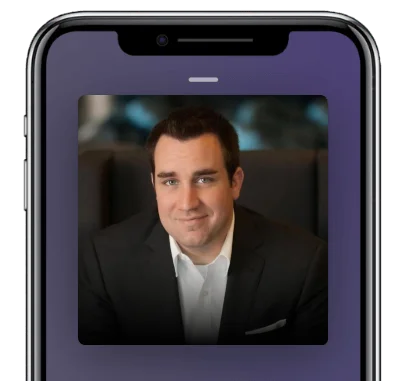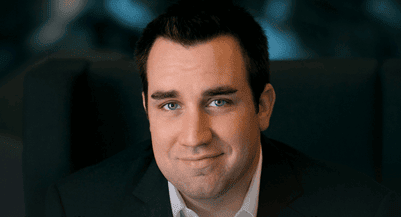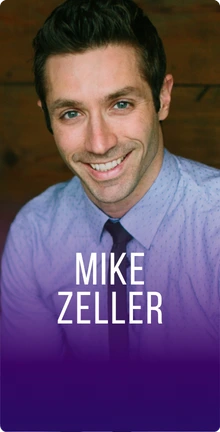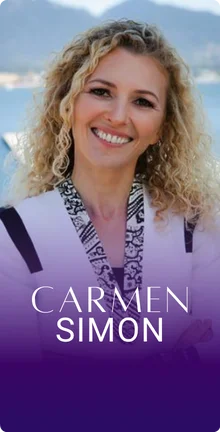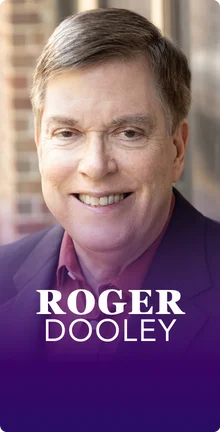Thanks for having me. It’s good to talk to you. It’s been a little less than a year, so I was excited to talk to you again.
I had you on my other show on Marketing Speak and we talked about your book and how it relates to marketing, building a more effective social network, using it in social media and so forth. It was well received. It was a great episode, so I’m excited to have you back on this show.
Thanks for setting the bar really high that now I have to clear that one but we should be able…
We’ll totally be able to do it. One thing that I was just really impressed by and didn’t realize how difficult it was—this is a little off topic but I think it’s interesting—you write regularly for HBR (Harvard Business Review). I did not appreciate how difficult that is until I finally, after months of trying, got my first article published on hbr.org. That was back in January, it was all about business travel. I don’t know if I’ll be able to get published again there, but wow, that was an impressive feat. And you’ve published many articles on hbr.org, right?
Yeah. I have two defaults. I have my blog, if it’s a little bit of a smaller idea or usually a lot on what goes on davidburkus.com that are inspired by episodes of The DailyBurk, which is my little two-minute flip-open-the-camera-and-offer-a-tip-on-social-media type of thing. Then HBR gets the bigger ideas. The big hint is that when I’m either testing ideas to see which one might be book-worthy or after there is a book, trying to get those ideas out there; HBR is usually where we start. It’s interesting because actually it’s gotten harder for everybody, not the way things go, but I had over 5–6 years of network to myself into where we knew a lot of the HBR folks and that sort of thing. So, it gets easier after you get that first one in so don’t worry.
The issue is that all of them have gone on to bigger and better things. This year, I’ve been rebuilding the network with them, which editors I want to work with more often and that kind of stuff. But it’s a fantastic publication and besides just the website, they have a book publishing arm and now they are doing multiple different podcasts. They’re putting out a lot of cool content which is great because I think a lot of people think of them as this sort of stuffy, almost academic journal-type thing and they’re really managing this transition to digital media really well. It’s just fun to be a part of it and congrats on you for being a part of it as well.
Thank you. It was like a Herculean effort but hopefully, it will get easier; we’ll see.
I mean, some of us who do their stuff we’re not used to the idea of working with editors, but it’s definitely worth it when you look at the piece at the end.
Yeah, they are very exacting. Incredibly high standards. Anyway, let’s talk about your social network and what does that mean for you versus what our listeners probably think when they hear the term social network?
The first thing we should say is to split out this idea. I think a lot of times people think of social networks as equivalent to social media. When we are talking about this, I will deliberately be talking about online things like LinkedIn, Facebook, and Twitter as social media and social network is broader – who do you know, who is connected to whom, and what have you.
Be deliberate about who you're spending your time with and who you're letting them introduce you to because networks over time tend toward clustering and similarities. Share on XI think a lot of people when they think about their network, they think about first-degree connections. They think about the people that they know and the degree of strength of that relationship. Are they close friends? Are they acquaintances? What have you? But we have a very egocentric approach to this, where it’s just us and then who our collection of contacts is.
In fact, sometimes people think of a network literally as the list of contacts on my phone or connections on LinkedIn. I think that’s the wrong approach because I wrote a book around why it’s the wrong approach. Where I started in this whole world is from the world of network science—the people who study whole communities and how they’re connected and interact. One of the first things that you learn is that a better way to look at this whole thing is not that it’s your network. As I like to say, you don’t have a network, can’t grow a network, can’t build your network, can’t expand your network, it’s not yours. You exist inside of one and your best bet is to realize that your job is to navigate that network, but also to create value for that network and let that value then spill back over to you.
If you want to talk about in the context of get optimized, there’s a ton of research that suggests that the networks that we’re embedding ourselves in, that whole community can positively or negatively impact our life, not just in the first-degree connections. So, having this network mentality instead of just the first-degree-who-do-I-know mentality is hugely important.
Let’s talk about that because how does this affect your life in terms of the relationships that you build? How you show up in the world? How you excel in your career and your business? Maybe even how you evolve spiritually? The soul is impacted by your social network and the interactions you have, not necessarily online but with people at your church, or at your community groups that you participate in, when you go to networking functions, your work environment and so forth, right?
Right, and it’s even further. We’ll go wide first and then we’ll narrow it down. There’s some fascinating research by a number of different researchers but it started with two guys, Nicholas Christakis, and James Fowler. They reanalyzed this data set that was the Framingham Heart Study. Framingham, Massachusetts has been running for the better part of almost four decades now; an ongoing heart study. People volunteer in and they track them over their lifespan if they can. They ask them a bunch of medical questions but also social questions and what have you.
What Christakis and Fowler realize is that because of the social connections, both who you go to for emotional support and who you know and who you consider your friend is part of the study. So, they can reconstruct a network of Framingham and then the larger community that was around it. They built these tens of thousands of people model that spanned over 30 years to see who’s connected to whom.
What they found was that who you know has large impacts on things like obesity. If you have a friend who is obese, you are more likely to develop obesity yourself. Smoking rates, whether it’s adapting or quitting smoking, happiness, life satisfaction, but the interesting thing is, it wasn’t just the friends. This is why we’re going wide first. It was your friend of a friend, even if you haven’t met them, and your friend of a friend of a friend, are having a statistically significant and causal influence on you. This is what Christakis and Faller called the three degrees of influence.
The weird thing about this is we don’t know why. We haven’t figured that part out yet. The working theory is that the people that are around you, those people that your talking to every day, are obviously shaped by the other people that are around them. And over time, that sets norms of behavior; what is acceptable or unacceptable.
To use the obesity idea, how many calories a day, what’s the acceptable meal to sit down with someone, or even just what is the right amount of weight around my center before I have to buy a gym membership. All of these little social norms are developed, not just by the people you are interacting with every day, but their friends and their friends of friends, even if you haven’t met them.
We’re tribal people, so we’re all influenced in that. That’s wide. Even on the just first-degree connections part of your network, there are huge impacts because ultimately who you know is a source of where you’re going to get your information. And you can get that from wide and diverse set of sources that will improve your thinking, allow you to see opportunities, make new connections for job or business purposes, or you can have a very clustered network that is very self-similar, that doesn’t really get all that open and not really exposed to new ideas.
It’s really your call, but one of the things we know from the research is that if you want the open one—I did just sound like it was the way better option because it is—you usually have to be more deliberate about who you’re spending your time with, how long, who do you’re letting them introduce you to, etc. because networks over time tends toward clustering and tends towards similarities.

This is why large organizations deal with silos, politics, and turf wars almost all the time because of human nature. If you just allow the people you know to develop organically, people have a tendency to spend more time with people who already think like them and make them comfortable, the fancy term is homophily or love of saying. That’s not a recipe for growth.
That’s an echo chamber and that shows up in our Facebook feed and other social networks as well, online.
Totally. The thing I thought was interesting is that the last two to three years, we’ve finally come to terms with the social media echo chamber, but one of the things we don’t realize is that it’s been happening on the natural level too, on an offline level.
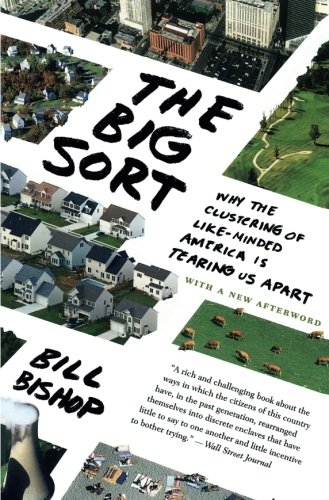
There’s a fascinating book and study called The Big Sort that shows that at the neighborhood level —not at the state level like red states or blue states in America—people are migrating towards people that vote in similar patterns to them. They’re picking up on little cues like if you drive a Ford F150, I can probably guess what political party you’re lined with. If you drive a Subaru, I can probably guess.
We look at these little clues and we let that determine which neighborhoods we feel comfortable in and literally at the neighborhood level, we’re doing this. Like you’re in Santa Monica. We tend to think of California as a blue state, but there are pockets just inside or outside of every major city in California where red folks—that sounds weird saying that but you know what I mean—red voters are gathering and clustering.
The online echo chamber is a huge problem but for the past 40 or 50 years, this big sort, as people have been clustering towards ideological similarity has been going on underneath the surface. I hope that our conversation about online echo chambers translates into that offline echo chamber thing as well.
How does somebody, first of all, see the clustering that’s happening in their lives so that what becomes visible becomes actionable? I can take some sort of action to fix it, but also then what do they do to fix it?
I start with that seeing piece, so I recommend a lot of people to literally do an audit of your time. Go back through your calendar, your email chain, your phone calls, and you don’t have to do everyone but you want to get at, let’s say two dozen or 25 people that are your most frequently interacted with in the last 3–6 months, however far you want to go back. For most people, you can fill out the top 10 of this just from memory but getting to that two dozen is really important. These are work and personal conversations.
If you think about the list, that’s the left-most column. Then make the right columns down the line, however many you want to make for what you want to judge for. Some people know they don’t have a problem with this political ideology thing, but they want people who have different life experiences or they want people who come from different countries or ethnicity so they can see those different perspectives.
When I worked with organizations, a lot of times they say gender question. Who are you spending your time with and are you doing it? In that context. Whatever you want to make those columns to the right and then go in and fill it out. If you don’t know, try and figure it out. Have that conversation, it might feel comfortable because you don’t have to ask who did you vote for but you can ask policy questions or things that lean that out.
The big thing to keep in mind is these are people you like talking to. They’re you’re most frequently interacted with. Whatever their answers are doesn’t change how likable they are to you, but you’ll be surprised. When I tell people to do this with 25, about 5–6 people are actually very different from you in some of those columns. Those are the columns that we’ve actually never had these conversations in, usually because you’re different so you just don’t bring it up. That’s good news. Ideally, it would be better if it’s bigger and some people have scored higher but most of us take the top 25, 15–20 are every self-similar and five or six are very different.
Engaging in an activity with other people builds better connections. Share on XNow, you know who those people are and you can work to spend a deliberate amount more time with them. Unfortunately, these five or six people are also going to be fairly down on the list of top 25 if you rank them but now we know. Now we can spend a deliberate amount of time. Now we can try looking for introductions through them, to more people that would help you expand on that and learn about that, or even just be open to see who else they would call their community. Once you know, you also have the recipe for getting out of it which is spending more time in those communities with those people so that you can see from their perspective a bit more.
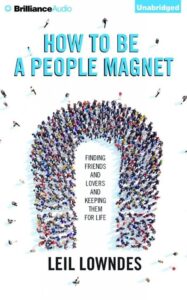
That’s really cool. It reminds me of my HBR article, I mentioned this concept I learned from a book called How to Be a People Magnet, and that concept is called scrambling. It’s where you go after interest you’re not really that keen on. Let’s say, you’re not really into golfing—I’m not—but you go out of your way to get a golfing opportunity because you want to scramble. You want to mix into your routine some new stuff and meet some new interesting people. I think that’s a really great way to go and a nice way to bring in our conversation on HBR and what we’re talking about regarding expanding your social network to be not as self-similar and more diverse.
You know what’s funny is, I guess I never thought of it as scrambling but when I was younger and childless, we did that a lot. My first book was around creativity and innovation. We just did it from the different thinking and perspective idea. So, I would scramble and would drive my wife crazy.
I signed up for a fencing course one time. I spent eight weeks learning the introduction to fencing to figure it all out. I told myself, I want to watch this on the Olympics and know what’s happening. You meet very interesting and different people when you do that.
After that, I signed up for a triathlon. I found a group that trains together for sprint triathlons, which are the ones that only take about an hour or an hour-and-a-half because I wanted to be a triathlete, but I also wanted to be lazy. I signed up for one of those and embedded in that community for six months or so.
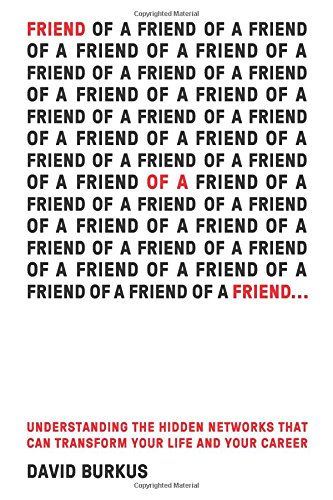
I had always thought about it as a skill when I was doing it. I just wanted to learn about the skill, I just wanted to learn about this field. Fast forward, five or six years when I’m writing Friend of a Friend, I saw it from that connection standpoint. I’m still talking to some of those people. Not from the fencing community—that was a really interesting community—but from the triathlete community in other places. I’m still interacting with those people.
Not only is it good from a people perspective and different perspectives but there’s a lot of research that—the term that McKinsey always coined was T-shaped— if you have a deep level of expertise but you keep a working knowledge of lots of other areas, you’re much more likely to find solutions to the problems that are in your deep area from the horizontal where you are, a mile wide but an inch deep. It can actually be a good thing as long as you’re deep somewhere because you can find insights from that inch deep, bring them over, apply them, and then it’s suddenly this disruptive innovation in the industry. All it is is what you saw in the other community. Scrambling is a good term for it. I love it.
I really like that concept of T-shaped. It reminds me of a conversion I just had earlier this week with a prospect, an SEO consultant. He talked about SEO and how getting a high ranking in Google can be informed by a diverse set of experiences. If I were to just pigeonhole myself when an industry is vertical and just be the SEO guy, in regards to online retail or in regards to publishing industry or something like that, it wouldn’t give me a diverse set of experiences to draw upon. For example, working on a video sharing site in the past formed my decisions and ideas for e-commerce site SEO.
They’re so vastly different from each other. Trying to get people to collaborate, the whole community aspect of a video sharing site like a YouTube-type site, and applying those strategies to an e-commerce site, back in the day was very innovative. That’s T-shaped. I think this applies to pretty much everything that you do – hobbies, interests in business, career, and relationships. I think that’s a great model. Where did you say that you learned this from?
The original people that I think coined the term was McKinsey & Company, they’re consultants. They got pushed back on the idea that was like, “Wait a minute, your consultants are consulting on all sorts of projects, finance projects, human resource things, whatever. How can the same people be good at all of these?” They responded back, “Our people are T-shaped,” and it worked. They convinced the market to keep buying from them. But it was actually the design thinking community, companies like IDEO and Continuum.
They started out in industrial design but like T-shaped people, now they’re doing all sorts of experienced designs and those sort of things. They ran with this idea and they said, “We seek to hire T-shaped people because we don’t know what kind of problem we’re going to solve down the road.” You don’t have to be a mile wide and a mile deep in everything because we live in an age where the entire wealth of knowledge is in our pocket if only we could figure out the right search term.
Being T-shaped basically allows you to do that. If you have little connections to certain communities and you know a little bit about how it works, you at least know, “Okay, this is who I can talk to about that.” To bring who you’re talking about your business travel article because we both travel pretty intensely.
I have a friend who I met not through this world but through the world of Brazilian Jiu-Jitsu who is an airline pilot. He flies mid-range air crafts, the Boeing 737 Max 8. I was like, “I understand a little about what’s going on but at least now I know who to talk to about what is this, what’s the story behind this, and what’s really going on, etc. because I had a pilot friend.” What’s funny is I remembered conversations with him as if he was a 737 pilot, but he’s not. He sold out to Airbus that might have influenced this conversation.
The point is I knew who to go to. This T-shaped idea, you’re building out not only this knowledge-based but those connections, now you know who to go to when you have a problem that seems like it tangents off in that area.
I’m curious, does your audit includes not just who these top dozen or so people are but also whether you’re T-shaped, you’re scrambling enough or are pigeonholing yourself into the comfort zone too much?
The audit that we described is really an audit of who these people are, that’ll obviously have an effect on your T-shape. You’d have to do something similar to how you’re spending your time in terms of learning. It’s funny as I was talking to my seven-year-old about this the other day because he wanted to stop doing soccer practice. I’ll tell you what this means in a second, but he asked me, “Okay, but do I have to do a different sport?” I looked at him and I said, “No, but you have to do one hard thing.”
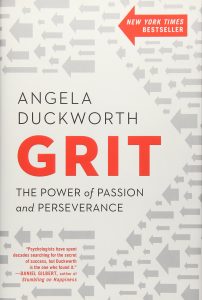
Where I stole that is from Angela Duckworth, the researcher who developed the concept of grit and all of that. She talked about her kids. The way that she’s trying to develop grit in her kids is, in their family, they have this thing called the one hard thing rule. You have to be always doing one hard thing. It’s usually not what you’re getting paid to do because you’re already good at that and you can grow in that area for sure, but you’ve got to be doing something else. It can be a sport, it can be a musical instrument. I have a feeling with the way his mind works, we’re going to flip all the way from sports to teaching him coding. But the point is you’ve got to be doing that one hard thing.
That’s my big challenge when people say, “How do I know if I’m being T-shaped?” I tell them, “Really, I don’t know because I don’t know you enough. I don’t know how long it’s going to take you to rework that knowledge. The easy solution I can tell you is if you commit to doing one hard thing in your extracurricular time, then you’re on your way to being T-shaped.”
That’s a great way of inspiring your kids to grow and evolve. I like that a lot.
Candidly, I think that right now we spend way too much packing kid’s after-school schedule. I’m also a huge proponent of unstructured imaginative play time. It’s also like one is not only the maximum. It’s also the minimum. There is one after-school curricular activity that you have to do that stretches you. If you like soccer, you’re good at it, and you want to go back to it, great. But if it’s easy and you’re just playing pick-up games for fun, that’s not one hard thing. We still have to have one hard thing.
Oftentimes, the kid follows in your footsteps. Let’s say that you dig into music, then your kid is probably going to dig into music. I was just at a Roger Love seminar, he’s one of the pre-eminent voice coaches of all time. He coached all the big names in terms of singers and actors who sing. Roger Love coached Bradley Cooper, Selena Gomez, all these big name people and made a huge difference in their careers.
I was at his seminar and he was sharing with the audience the travails of his daughter, Madison Love, and how she is this huge singer and songwriter. She’s won all these awards and had countless millions of listens on Spotify for her music and a bunch of the music that is playing on the radio, she was this songwriter for. I’m like, “I know that song. Oh yeah, I know that song too.” It makes sense when you’re raised by one of the top voice coaches of all time to get in that world and become really excellent at it.
Another example, my oldest daughter is an SEO expert. She was on MSNBC last year talking about SEO. She has a successful business with the clients like the State of South Carolina and so forth that she got, some of them from her TV appearance. And she has done a bunch of speaking at conferences. She started doing SEO at 14 years old, she’s 27 now.
Another example of apple-doesn’t-fall-far-from-the-tree, but it sure doesn’t sound like scrambling or anything like that, it sounds like they’re following in your footsteps. I would love for people to inspire their kids to do something completely different from what they’re doing in their career or in their gift.
I think the thing about the one hard thing rule is that like the concept of being T-shaped, it doesn’t necessarily have to turn into your thing that you’re known for. At the center of all of my work is the idea of being a writer and then off of that comes speaking and a bunch of other stuff. My one hard thing for the last 13 years has been Brazilian jiu-jitsu because it’s infinitely hard. It never gets easier. You just keep progressing. But I’m not good at that. It forms a lot of things, but it’s not in my career path.
I think if you’re in that situation where you are lucky enough to share the love of what one or both parents are good at, I think the one hard thing rule should still be applied and that isn’t necessarily the hard thing, it probably comes easy. All of those are great examples of how opportunity flows through networks as well. You see the same thing.

You mentioned those two examples. But you see, if you look at players who make it into the NFL, one of the things they are most likely to be besides fast, strong, and usually tall is to have had a dad who is in the NFL or to be coached by someone. To have that kind of inside connection not just because it’s all an insider thing, but it opens you up to know who to go to for development at an earlier age, it opens you up to reflect when you need another opinion, and it opens up the actual opportunity that people know you and so they’re much more likely to be watching you.
The downside of this is, “Yeah, my dad is like a middle manager at some company that I don’t even know what they do. How does that help me?” I think it’s a lesson in you to be deliberate about finding those same opportunities yourself and vetting yourself in that community that some people were lucky enough to be born into.
In network science, there’s a term called preferential attachment which is people who are most connected are most likely to make new connections because they already know so many people. They just let it happen organically; it happens much more often. The interesting thing is that preferential attachment is like a snowball, it builds over time.
I don’t think the answer is to look at those examples and go, “Oh, so it’s all just who you know and I don’t know anybody, so I’m out of luck.” You’re not. Those people are leveraging preferential attachment and you can too. You’re just going to have to work hard in the first years to build up that same momentum that they were lucky enough to be handed.
That reminds of another example. I don’t know if you’re familiar with Bo Eason. He’s a former NFL player and a professional speaker, really entertaining. He’s a great storyteller. He talks about when he was teaching his kids to be excellent, that he’s teaching his kids to never let the ball hit the ground when they were playing catch. He was at some birthday party of his child’s friend, they’re playing catch in the backyard, and one of the critical mothers watching them was like, “Why do you tell them that you don’t let the ball hit the ground? You sound uptight. Just let them be a kid or whatever.”
He got really upset about that because in this era of every child gets an award for participation, there’s no striving for excellence and having that bar very high. In fact, if you watch this whole video clip called don’t let the ball touch the ground on Bo Eason’s website—it’s really a powerful story of how making it too easy on our kids where we don’t demand excellence, sets them up for mediocrity in their adult lives. I wonder what your thoughts are on that.
From a parenting perspective, I think there’s a delicate balance there, too. You can be that parent that grinds it too much. To my knowledge, they don’t hand out college scholarships to nine-year-olds. Knowing that delicate balance, I think it was really important. For me, personally, my own experience has been that usually non-family mentors have been better, they’ve been a little bit better at navigating that. It’s hard for me to give feedback to my seven-year-old because I have a higher expectation that he has. The teachers that deal with him on a daily basis at school do a much better job giving feedback because they know what a seven-year-old should be capable of.
You definitely want that pursuing excellence thing. You go, “Here is the world of possibilities that are open to you if you’re a little more serious.” On the other hand, did you ever see the movie Whiplash about the drummer and how just insane that whole thing came? That’s again what I like about the one hard thing rule, is that it has to be hard. It doesn’t have to be impossible, crazy, and demanding but it can’t be, “Let’s just be kids either.” Hard also changes as you progress and as you develop.
We were talking about soccer when we got into this whole thing. If we use soccer, there are rec leagues, developmental leagues, and competitive leagues. If you just stay in your rec league your whole life, it might be hard for the first couple of years but it won’t continue to be hard. You’ve got to move up alongside that progress.
Social media is a supplement, not a replacement for your existing offline network. Share on XAs a parent, I’ll be honest with you, I struggle with that. Knowing what is the right balance of how far do we push them right now, etc. This idea that as long as it’s hard, it’s okay, it’s enough. It doesn’t have to be too hard but it can’t be easy. That’s been, at least, been really good for me in thinking through managing that tension.
Another thing that is related to this is this idea that you’re the average of the five people you hang out with the most. If you want to be more excellent or more outstanding, then hang out with more outstanding people. I think it was Jim Rohn who said that.
It was Jim Rohn originally. I got hate mail from Jim Rohn fans because I have a Medium article that I published and titled You’re Not the Average of the Five People You Interact with Most that went viral. It was talking about the Christakis and Fowler study. Certainly, it doesn’t actually neglect that you’re the average of the five people. My problem is I don’t think it’s five. I think it’s almost infinite because of these three degrees of separation thing. You’ve got to pay attention to people that you’re around. If their friends and friends of friends are influencing them and that spills over onto you, you also have to be aware of that.
Every parent knows this because every parent has seen who their kids are developing friendships with on the playground and then looked over at those kid’s parents and made judgments about whether or not we wanted to be around them and whether or not they reflected the same values that we reflect. That’s a small-scale example of how these three degrees of influence affects. There’s no judgment on the kid. We don’t know anything about the kid, but we can make some guesses based on other relationships. I think you’ve got to pay attention to more than just those five people.
The other thing that I think is good about, we were talking about this audit, these differences audit to look for is that sometimes that difference can just be, are they excelling in this field and I’m not? Now you’ve identified who those people are. Of course, I will make a strong bet that if the people that are on your new five, meaning I want to hang out with these people more often, one of the things that will happen is they will introduce you to more people in a network and it will gradually change.
If you’ve ever been a part of a mastermind group or you regularly attend the same conference every year with people that are doing at your level or above your level, you start to get introduced to more of those people and your mindset changes over time because it’s about more than just those five people. Start with the five, but keep a working knowledge of what’s going on outside of that five who are wanting two degrees of separation out.
You mentioned having this on a sheet of paper with columns and so forth, do you have a template that you could share of this audit of the two dozen or so people you talk about?
I do, actually. I have at the end of every chapter of Friend of a Friend, there’s an activity. We also have a workbook that goes along with. Basically, you pull all the activities and then create worksheets for each one. That’s davidburkus.com, I’ll get you the links so that we can link directly to it in the show notes page. For every book we do, we come up with a bunch of different PDF resources and videos. We have them all on our site on this resources tab just to go along with it. I would obviously love if people buy the book but if they just get the free PDF and it helps them, that’s awesome, too.
Awesome. Hopefully, they will buy the book.
But if you’re clicking through the show notes and you’re going to that, please know that I have nothing against Jim Rohn. It’s not an attack on Jim. It’s just that building off of Jim’s concept, let’s look at more. I do not need more emails from people to think I’m trolling Jim Rohn.
For sure. Let’s move on to talk about how to be more effective at networking. You mentioned masterminds as a place to go and meet cool people and expand your network. Let’s talk about networking in masterminds, networking functions, conferences. What are some best practices and tips and tricks?
One of the first is that I think a lot of these unstructured meet-ups that have always been popular but we’ve always gone to and have been uncomfortable at, are actually relatively ineffective. There’s research that suggests that people spend most of their time at these events with the two or three people who they already know. Which is actually fine if you’re using this as a reconnection of what we call weak or dormant ties—we could talk about that a bit later. But if you’re looking to make new context and what have you—Brian Uzzi and Shannon Dunlap are the two that have spearheaded this—there’s an idea they call the shared activities principle which is that you want to look for activities where there’s more going on than just being there to connect.
In terms of conferences, you know how everybody always says, “Skip the sessions and just hang out in the hallway.” Well, people usually spend time in a hallway talking in the same two or three people they already know. Go to the sessions. More importantly, go to the other activities they go to on. They define a shared activity as a situation where there is something other than connecting that is the reason that we gather. We’re there to do something. It could be learning, but it could be something else.

An example I always use is Habitat for Humanity. One of my friends that I wrote about in the book is a man named John Levee who throws his dinner parties in New York City where everyone actually is cooking as well. The thing we’re doing is where they cook because engaging in that activity, it turns out, builds better connections. That’s only quality one. Quality two is that there are stakes. It’s possible to fail. In other words, we’re there to do something and we have to actually do it, so we’re invested in it. The third quality is that the achievement of that activity requires interdependence. We’re all doing it individually and then we all learn.
This is one of the challenges with a lot of conferences that are just speakers, speakers, speakers, speakers instead of a workshop or discussion format. There are no interactivities so there’s no conversation that happens, but you have those three things. People are there to do something, the thing that they do has stakes—you could succeed or fail—and that that success requires interdependence.
The research suggests that you are much more likely to make a deeper connection with people who are similar to you and also to meet people who are different than you because we were talking about earlier that tendency towards self-same. When you’re there to do an activity, you don’t have time to have that usual who are you, what do you do, elevator pitch conversation. We’ve all been name-badged at a networking event which is where somebody is talking to you, they look down and look at your name badge to see who you are and what you do and then they decide whether or not you’re valuable. Suddenly you can feel them looking over you towards the next person.
You can’t do that if you’re there to do something, even if that something is just to help marinate the chicken for the dinner that we’re all doing like in John’s dinners. There is a better quality conversation that happens as you’re doing it because you don’t have time to follow that normal script. That’s my biggest encouragement if you’re trying to make those new connections, seek out shared activities. That will honestly have some effect, what type of conferences you’re going to, what types of meet-ups you’re going to, it’s usually better.
If you think about a trade association, it’s usually better to go to their volunteer events than to go to their monthly networking lunch thing because there’s something to do with the volunteer event. You’re going to meet people. If you look at a conference agenda, a conference program, it’s all just content delivery and there’s no discussion, there’s no workshop, there are no activities built into it. You might not end up making as deep connections as you think. So, pay attention to what’s going on at these events, not just that I have to go to some of them.
What would be an example of an event that is built around these shared activities? Maybe a conference or a mastermind that you’re particularly fond of.
I’ll give two examples, one that’s individual and one that’s corporate. I’ll brag on my buddy Jayson Gaignard. He runs an event that is terribly named because it’s called MasterMind Talks. It’s different than a normal 12-person, Napoleon Hill idea. It’s a conference that’s capped at about 150 people, it’s invitation only. There’s only about half the group that comes back every year. It depends on just who you are and what you do, but they’re trying to get half of it to be new people and half of it to be people who are reconnecting every year. You can always take a year off and come back and that sort of thing.
If you look at the agenda, there’s a mix of different things going on. There are speakers or what we’d call keynoters that are the bigger events and then there are round tables where we’re going to have a discussion about, “This is the topic and here’s who’s facilitating. In here, she is an expert but we also want other possibilities.” Then almost every single day, there’s an activity built in like skeet shooting, ATVing, horseback riding, hiking, wine tasting depending on the region, or surf instructions. The idea is afternoons are a different activity just to take everyone’s mind off it and encourage conversations that wouldn’t happen when we’re all doing that. That’s one is my favorite. You can apply for that one, it’s a great event. You can also just look at the conference program and get a sense of what’s going on in that regard.
Inside of large organizations, I’m actually a really big fan of how Pixar runs this. They actually use their training and development department. Most of us think of T&D departments as primary training, initial compliance training, or initial training for your job or what have you but they’re regularly running courses and stuff that might just be fun. Let’s say improv classes, or karate classes, or drawing classes for people who aren’t animators. The idea is that anybody can sign up for it as a company and you’re allowed to spend four hours a week at training. The idea of being that you’re going to get to know people. If you’re not drawing class and you’re the janitor, you’re going to get to know somebody else who’s an admin that you wouldn’t regularly see, so you’re going to develop those relationships.
When I was writing Friend of a Friend, I featured Pixar. One of my favorite stories was a guy describing how he went from an intense board meeting where he had to pitch an idea to his bosses and his bosses’ bosses to an improv class where you got to hit one of them with a rubber mallet over and over again. You’re in front of the shark tank-like event and then two hours later, you’re all just improving and you end up fighting with rubber mallets with the same people that you were just in that boardroom with. You develop a little bit different relationship when things like that happen.
That’s really cool. I like that. When you were talking about MasterMind Talks, I’ve heard good things about it. I’ve also heard good things about Baby Bathwater and Summit Series, multiple of these kinds of organizations, masterminds, groups that do out of the ordinary sorts of things. There’s another one that I’ve heard of, it’s The Brotherhood. Have you heard of any of these?
I have. We wrote a bit about Summit Series in Friend of a Friend. I have a couple of friends who are in The Brotherhood. Baby Bathwater, I’ve heard nothing but good things about, except I’ve also heard things like possible use of psychedelics and drugs that are only legal in certain states. I’m always tempted to go, “Yeah, go to that one,” but no, I’ve heard a lot of these.
There are ones that I’ve never even heard of. All the ones that we just listed actually skew males. Some of them were working on more equal representation. If you’re listening to this and you’re female, there are other events. You just have to dive into the actual agenda, what actually happens at this event, which is different because most events market based on who is speaking from the main stage. Most of these events are saying, “Come to our event and you’ll hear from Gary Vaynerchuck and Tony Robbins.” That’s great but you’re not going to get to even shake their hand probably. What you care much more about is what goes in small groups. What are the breakouts look like? What are the activities that are built into the day look like? Have they even thought to build activities or not? Those things are really telling and what’s going to create an authentic experience.
Mix into your routine some new stuff to meet new interesting people along the way. Share on XMost conferences are just the talking head at the front of the room spilling out content and you’re just sitting there taking notes. It’s a very passive activity. There are the occasional conferences where they do it differently though. I’m doing conferences constantly. There’s one in particular that stood out for me as a speaker that was really valuable and very interactive. It’s the eTail conference. It was the round tables that they did where they brought in all these speakers, me being one of them, who were in charge of one round table. They would rotate the round tables so that people would come, topics, specific round tables. Let’s say mine was on enterprise SEO or scaling SEO on a large site or whatever. They’d sit at my round table for the half hour session and there’ll be about 12 of them and we would brainstorm, troubleshoot, ideate and all that. The half-hour would be finished and then they’d pick another table to sit at and have another speaker/facilitator lead that discussion. That ended up being very effective from a lead generation standpoint for me but the thing I didn’t like about it is that in order to speak, you had to pay.
I usually get paid to speak, not the other way around. I didn’t end up doing it further years because I ended up selling my agency and we didn’t have that kind of a budget to spend on fees for the opportunity to speak, so I stopped speaking at eTail. Every single one of their speakers that’s a vendor, that’s like a service provider, not the retailers but the service providers, they all had to pay to speak whether it’s a panel or it’s a keynote or anything in between, they all paid and it can be an insane amount of money. A keynote might be $50,000, $60,000, $70,000 or something.
Interesting. Now that you mentioned it, events that actually pay their speakers and have something similar, you’ve got to look by your industry, but I spoke at an event for residential interior designers. We’re talking top of the top. One of them was talking about how he was designing a house for one of the executives of Under Armour. So, we’re talking about expensive houses. It’s about 175–200 of them and they pick a different place every year. The year that I spoke at their event, they were in Greece.
Their rule is they invite speakers in, they have two what we call keynoters per day but one of the things they require is that you actually be there for all three days of the event. You’re going to all of the dinners. In our case, we’re like, “We’re going to do a tour of the Acropolis on this day, we’re going to do this thing on the coast.” It’s a vacation but I gotta watch how these people interact. They have their best conversations when they’re walking around the ruins of the Acropolis, not when they’re sitting, all staring at me which of course makes me feel horrible about the value that I provided.
They’re definitely there and they’re there in every industry. You just have to dig deep to find them. The big key, I will tell you this regardless of what it is, one of the first keys to knowing what the right event is, is are they marketing who is presenting or are they marketing something else? Baby Bathwater, Summit Series, MasterMind Talks, they are marketing the event. They are marketing what you’re going to do and who you’re going to interact with. Some of these events don’t even pick who is speaking until they have the list of attendees and their needs. That’s one of the big clues. Even then you’ve got to dig deeper but that’s one of your really, really big clues.
Where would you say A-Fest—Awesomeness Fest—fits in so the event put on by Mindvalley. Is that more about the speakers? Is it more about the overall event or is it somewhere in the middle?
I’m going to have to confess, I haven’t ever thought deep thoughts about A-Fest, so now I’m going to have to. But it proves the point. If you look, you will find them because there are so many of them that between you and me, we can’t keep them all in our heads and we can’t track them all. They’re there. You just have to look a little deeper.
Some of the conferences like they’re put on primarily for the content and for the learning, they will try to facilitate the networking by having social functions with interesting activities and stuff but it may or may not be effective. One that I really thought was clever was at Social Media Marketing World. They had this social bingo sort of thing where, in order to enter this contest to win all these prizes from the vendors, you had to meet different people. There were different things like this person is a podcaster or this person was born in Ohio or whatever, all these random things on this scorecard, in this bingo card and then they would initial it if they were a match and you would have to try and get bingo.
Once you hit that, once you got a full line or diagonal or whatever, then you could submit the card as an entry. I thought it was really clever. We did end up initiating some conversations we probably wouldn’t have had with people waiting in lines and stuff because of the bingo cards. Have you ever heard of anything like this?
Yeah, I have. Since Friend of a Friend came out, I got emails from a couple of different creators of apps that do something similar or during this cocktail hour we’re going to have different tables set up and you can see them all in your app. I applaud their attempt to have a more deliberate approach to networking. I think most events though are just doing the broad unstructured hour and here’s an open bar and gosh we hope that maybe this is worthwhile for you.
In those situations, my recommendation to a lot of people is that those are the times to make a plan to reconnect with weak and dormant ties. We know that people spend most of their time on these unstructured events talking to people they already know so just make a plan. If you know you’re going to an event and there’s four or five people that you’re really good friends with, that you’ve known for a while, they’re going to be at the same event, instead of saying, “Let’s do lunch,” or, “Let’s get coffee during the event,” point to that cocktail hour and say, “Hey. You know what? Let’s meet up on day two at this thing.”
The reason that I say that is that, (a) you’re putting that slot into a time that you know would otherwise you’d be doing whatever, but (b) while you’re talking to them, what’s going to happen? People that they know that you don’t, but people that they know are going to come up and greet them, too, because we spend time talking to people we already know at this event.
They almost function as sort of a de facto wingman for you and you for them, and you end up introducing each other to people that now you’re making new connections, but it’s because you made the plan, let’s reconnect at this event and then just as their contacts come in, you’re getting to know them.
Interesting. Let’s unpack this a little bit. You just referred to weak and dormant ties in passing a couple of times. There are weak ties, there are close ties, and there are dormant ties. Let’s talk about the implications of each of these three types and some practical ways to expand on these weak and dormant ties that are going to improve the health of our social network and decrease some of the clusterings that are happening.
My apologies, by the way. I tend to geek out and start throwing out jargon when I get excited. If you think about your network, not all connections are equal. There are your close contacts which are people that the relationship is strong. These are the people that you would go to for emotional support, but these people often think very similarly than you because of that whole self-similarity thing we talked about a few minutes ago. In terms of new information, new ideas, and new connections, they’re not all that valuable to you which we know because that’s why we’re going to the conference, the networking events, and the meetups to try and meet new people.
The interesting thing is we jump over what I call the hidden network. Hidden because we go right from close contact to, “Okay, I’ll just try and get serendipity to work for me and hope that I meet someone new.” We jump over these weak and dormant ties. A weak tie is someone you know, but you don’t know that well. You see them usually only in one context in life. I often joke about these people. These are the people that you see them but you only see them at work when there’s cake in the break room. The rest of the time, you don’t really know. You might know their name and their title but you don’t really know about them. That’s fine, we can’t have deep relationships with everyone. That’s the way it is.
Then there are your dormant ties, which are people that you know and maybe you knew well but for some reason or another, that relationship fell by the wayside, either they moved or changed jobs or you just gradually fell out of talking to each other all the time. Because those people aren’t talking to you a lot, they’re less likely to have all of those same things in common, they’re much more likely to be in a different place in the network talking to different people, having different specialties, et cetera. They’re just as potent to the source of new information as these total strangers that we’re looking to convert in the contacts by “networking” and yet they’re much more beneficial to us because there’s no rapport-building phase. They already know you, trust you, and want to help you. They know as much as strangers but you don’t have to do that whole initial phase, you just have to rewarm the connection which is a whole lot easier.
Conferences are one of those places that are fantastic for either getting to know a weak tie more or in particular, what I like is focusing on those dormant ties. I know these people are going to be at this event, so I’m going to make a deliberate effort to reconnect. Even if it’s as little as a five-minute conversation, I’m going to reconnect with them so that we almost reset the clock on when it’s been the last time since we talked to them. And now, it’s much less awkward if you need a favor or they need a favor from you or what have you because you’re checking in with them. Sometimes it can be a year. There are other contacts that I have that I make sure to check in with every three months or so just because I’m trying to keep it.
I want more than my close contacts to feel like they can approach me at any time if they need help and to feel like I can approach them. The only way you do that is being deliberate about checking back with these weak and dormant ties. Conferences and live events are a great way to do that. If you can’t do that or you don’t do it that often, it can also just be taking the time when you see something they post online or when you read an article that makes you think about them taking the 30–45 seconds to send them a private message or an email that says, “Hey, I read this and I thought you’d be interested in it,” and then see if a conversation jumps off from that. These are little tiny habits that can have a huge impact on where you’re getting information and who your possible connections down the road are because you’re being deliberate about the network that’s around you.
Would you recommend this messaging happen via Facebook Messenger, Whatsapp, Gmail, or what?
It really depends on the context of you and the person and what have you. I will say it should be private, so it should be Facebook Messenger, or email, or a text message, not something that’s public. If you’re that kind of friend that clicks like when they post an announcement or only talks to them on Facebook when it’s their birthday and you’ve been reminded to, that’s not a really good basis. In my mind, I don’t even count that as a conversation. It has to be that private one-on-one conversation.
It should hopefully lead to something like a phone call or a face-to-face chat or a virtual face-to-face chat like Skype. Whatever it is, as long as it’s private like that, it’s good and it’ll be working. Which it really depends on the context. For me I look at it almost on an age line, those dormant ties that I like to keep a contact that are like over 50, it’s usually an email. If they’re under 35, it’s usually a text message. Even then, there are certain people that I talk to, Facebook Messenger, email, or what have you because that relationship determines that but it does have to be that private one-on-one conversation.
Preferential attachment is like a snowball, it builds over time. Share on XThat makes sense and you mentioned every three months or every 12 months, I’ve read somewhere that three months should be the minimum contact frequency because otherwise, they forget who you are. At least in a sales context, you definitely don’t want to leave it longer than three months, it’s what I recall reading about. Is there some science behind that or research?
No. We’re talking about potential sales prospects and those sort of things. I think it’s different, I think you want to stay a bit warmer. I use three months just because, like you, I probably read it somewhere and then just started doing it. There are definitely people that I don’t panic if I realized I haven’t talked to them in six months or so. I would say a good goal is to go with 90 days. Truthfully, a good goal is to get to the point where you’re in the habit of taking that 30 seconds when you read an article that reminds you or when they pop into your head as you get into that habit of doing that.
For a number of years I used a service called Contactually, which is a personal CRM, to send myself reminders, “Hey, according to this, you haven’t emailed them in 90 days. You should look for an opportunity to talk to them in the next week or so.” It would do that as a service, except as I have gotten the habit of regularly just pulling out my phone and saying, “You know what? I was thinking about you and our conversation from such and such the other day and wanted to let you know. I hope you’re well,” et cetera. Taking those little moments throughout the day to do that, I stopped getting reminders because I was keeping in touch with everybody I wanted to keep in touch with on that cycle. Ninety days is great as you’re being deliberate about it but the hope is you get into that habit where you don’t even need a reminder, you just do it naturally.
You’re impressive, you’re a very disciplined guy.
I should say the list, the database that was in Contactually was maybe 350 people or so. Some of that is just a function of time. I have to cut it off somewhere. There are far weaker and dormant ties that we have, but at a certain point, you’ve got to cut it off and say, “Okay, these are the people that I want to make sure that I’m investing in,” and that makes it a little bit easier.
It’s not like 5000 Facebook friends, they have to be reached out every 90 days.
It’s funny. We started at the top with this idea of social network versus social media. One of the creeds that I live by is that online social media is a supplement to, not a replacement for your existing offline network. To that effect, I only have about 125 Facebook friends and I have really strict rules for who gets to be that friend. My close friend actually joked about my Christmas purge between Christmas and New Years, I go back through that friend list and see if anybody’s crept on or there’s been a change in the relationship and we shouldn’t be that close.
My rules, by the way, if you want them is I have to have met you in person and I have to be comfortable with you looking at pictures of my kids because that’s the one place I’m going to post them, I won’t post them on LinkedIn or Twitter or Instagram or anything like that. I’m at no risk of maxing out my Facebook friends, I keep that one really tight.
I’m not really that active on Facebook myself because I don’t want to post to the thousands of friends, who many of them I haven’t even met, they’re just people in my industry. I don’t want to post all these photos of me on vacation and so forth and attract a lot of—I don’t know what the right word is—evil eyes essentially.
That’s exactly what happened to me. I get it. The second book came out and I didn’t realize I was open to followers. People that followed me were liking videos of my kid walking and I just got really weirded out.
I can understand that. All right. We’re out of time. If we could send our listeners to one or two resources, of course, your book would be one of them, what would be some URLs that we should send them to for learning more and upleveling their network?
If you liked this conversation, Amazon, if you just type in David Burkus, you’ll find it. I’m the only one, or at least the only one that’s written books. That’s really easy to find, davidburkus.com is also the website. Truthfully, for those who are listening to this, because I know you’re on your phone, you’re running, you’re in a car, or whatever, one best place is to go to the show notes for this episode. Stephen wants you to go there anyway because he makes them nice and pretty and puts all the resources there. Just remind yourself to go there and we’ll take care of everything else.
All right. Sounds good. Thank you, David. Thank you, listeners. We’ll catch you on the next episode of Get Yourself Optimized. In the meantime, have a fantastic week.
Links and Resources
- David Burkus
- Facebook – David Burkus
- Twitter – David Burkus
- Instagram – David Burkus
- LinkedIn – David Burkus
- Youtube – David Burkus
- David Burkus TED Talk
- You’re Not the Average of the Five People…
- Resources Page – David Burkus’ Downloadable Worksheets
- Friend of a Friend
- The Big Sort
- How to Be a People Magnet
- Grit: The Power of Passion and Perseverance
- David Burkus – MS previous episode
- Marketing Speak
- Harvard Business Review
- How to Make Any Business Trip Less Boring
- Nicholas Christakis
- James Fowler
- Framingham Heart Study
- Ford F150
- Subaru
- McKinsey & Company
- T-shaped
- IDEO
- Continuum
- Brazilian Jiu-Jitsu
- Boeing 737 Max 8
- Airbus
- Angela Duckworth
- Roger Love
- Bradley Cooper
- Selena Gomez
- Spotify
- MSNBC
- NFL
- Bo Eason
- Don’t Let The Ball Touch The Ground
- Whiplash
- Jim Rohn
- How to Build Your Network
- Habitat for Humanity
- John Levee
- Napoleon Hill
- Baby Bathwater
- Summit Series
- Gary Vaynerchuck
- Tony Robbins
- eTail conference
- Under Armour
- A-Fest—Awesomeness Fest
- Mindvalley
- Social Media Marketing World
- SMMW Social Bingo
- Contactually

